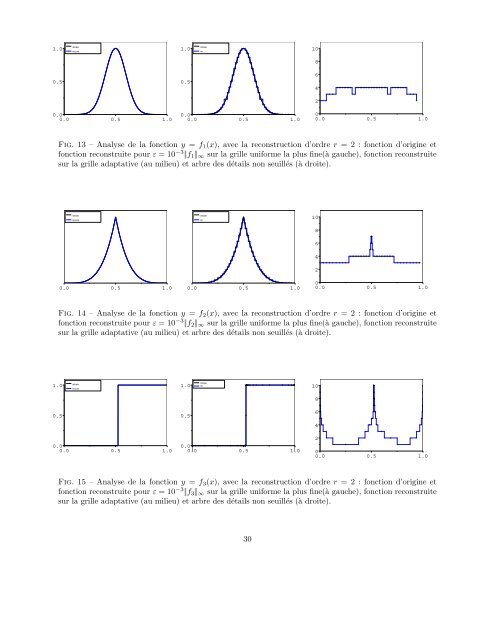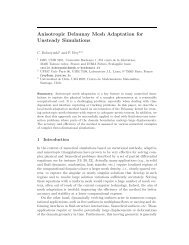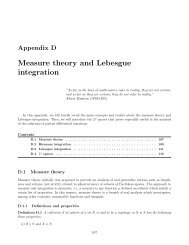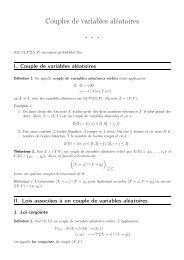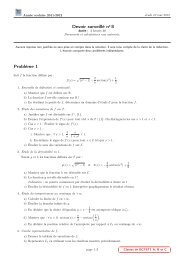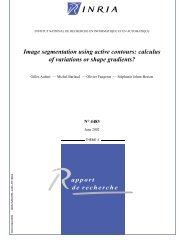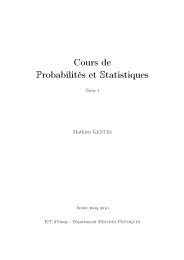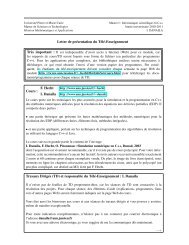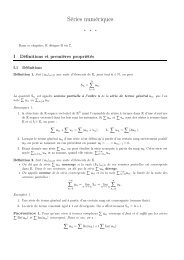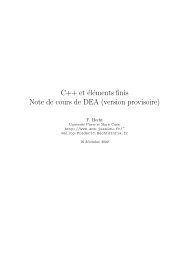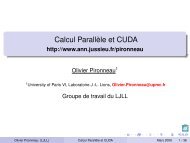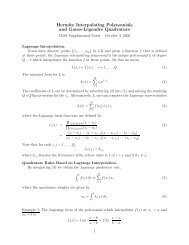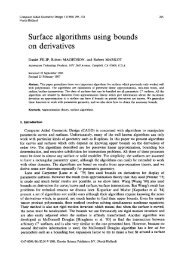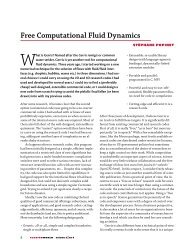Approximations multiéchelles - Laboratoire Jacques-Louis Lions ...
Approximations multiéchelles - Laboratoire Jacques-Louis Lions ...
Approximations multiéchelles - Laboratoire Jacques-Louis Lions ...
Create successful ePaper yourself
Turn your PDF publications into a flip-book with our unique Google optimized e-Paper software.
1.0<br />
0.5<br />
initiale<br />
recons<br />
0.0<br />
0.0 0.5 1.0<br />
1.0<br />
0.5<br />
initiale<br />
mr<br />
++<br />
+ +<br />
++<br />
++<br />
++<br />
++<br />
++<br />
++<br />
+++++ ++++<br />
++<br />
++<br />
++<br />
++<br />
++<br />
++<br />
++<br />
++<br />
+ +<br />
++ ++++++++++++ + + +<br />
+ ++ +++++<br />
+ ++ +++++++++<br />
0.0<br />
0.0 0.5 1.0<br />
10<br />
8<br />
6<br />
4<br />
2<br />
+ +<br />
+ + + +<br />
+++++++++++++++++++++ +++++++++++<br />
+++++++++++<br />
+ +<br />
+ +<br />
+ + + +<br />
0<br />
0.0 0.5 1.0<br />
Fig. 13 – Analyse de la fonction y = f1(x), avec la reconstruction d’ordre r = 2 : fonction d’origine et<br />
fonction reconstruite pour ε = 10 −3 |f1 |∞ sur la grille uniforme la plus fine(à gauche), fonction reconstruite<br />
sur la grille adaptative (au milieu) et arbre des détails non seuillés (à droite).<br />
initiale<br />
recons<br />
0.0 0.5 1.0<br />
initiale<br />
mr<br />
++<br />
++<br />
+ + + ++ + + + ++ ++ +++++++++++++<br />
++<br />
++<br />
++ ++<br />
++<br />
++<br />
++ ++ + ++<br />
++<br />
++<br />
++<br />
++<br />
++<br />
++<br />
++<br />
+++++++++++<br />
++<br />
++<br />
+ + + + +<br />
+<br />
0.0 0.5 1.0<br />
10<br />
8<br />
6<br />
4<br />
2<br />
+ + + + + + + + + +<br />
+<br />
+<br />
++ ++<br />
++++++++++++++<br />
++++++++++++++<br />
+<br />
+ + + + + + + + +<br />
0<br />
0.0 0.5 1.0<br />
Fig. 14 – Analyse de la fonction y = f2(x), avec la reconstruction d’ordre r = 2 : fonction d’origine et<br />
fonction reconstruite pour ε = 10 −3 |f2 |∞ sur la grille uniforme la plus fine(à gauche), fonction reconstruite<br />
sur la grille adaptative (au milieu) et arbre des détails non seuillés (à droite).<br />
1.0<br />
0.5<br />
initiale<br />
recons<br />
0.0<br />
0.0 0.5 1.0<br />
1.0<br />
0.5<br />
initiale<br />
mr<br />
+<br />
+++ + + + + + + +++<br />
+ + + + +++++<br />
+++ +<br />
0.0<br />
0.0 0.5 1.0<br />
+<br />
+<br />
+<br />
+<br />
+<br />
++<br />
++<br />
+ +<br />
+ +<br />
+ + +<br />
+ +<br />
++ +++<br />
+ +<br />
+<br />
+<br />
+<br />
+<br />
+ +<br />
++ +++<br />
+ + +<br />
+ + +<br />
+ +<br />
+ +<br />
0<br />
0.0 0.5 1.0<br />
Fig. 15 – Analyse de la fonction y = f3(x), avec la reconstruction d’ordre r = 2 : fonction d’origine et<br />
fonction reconstruite pour ε = 10 −3 |f3 |∞ sur la grille uniforme la plus fine(à gauche), fonction reconstruite<br />
sur la grille adaptative (au milieu) et arbre des détails non seuillés (à droite).<br />
30<br />
10<br />
8<br />
6<br />
4<br />
2<br />
++<br />
+ +<br />
+<br />
+<br />
+<br />
+<br />
+<br />
++


